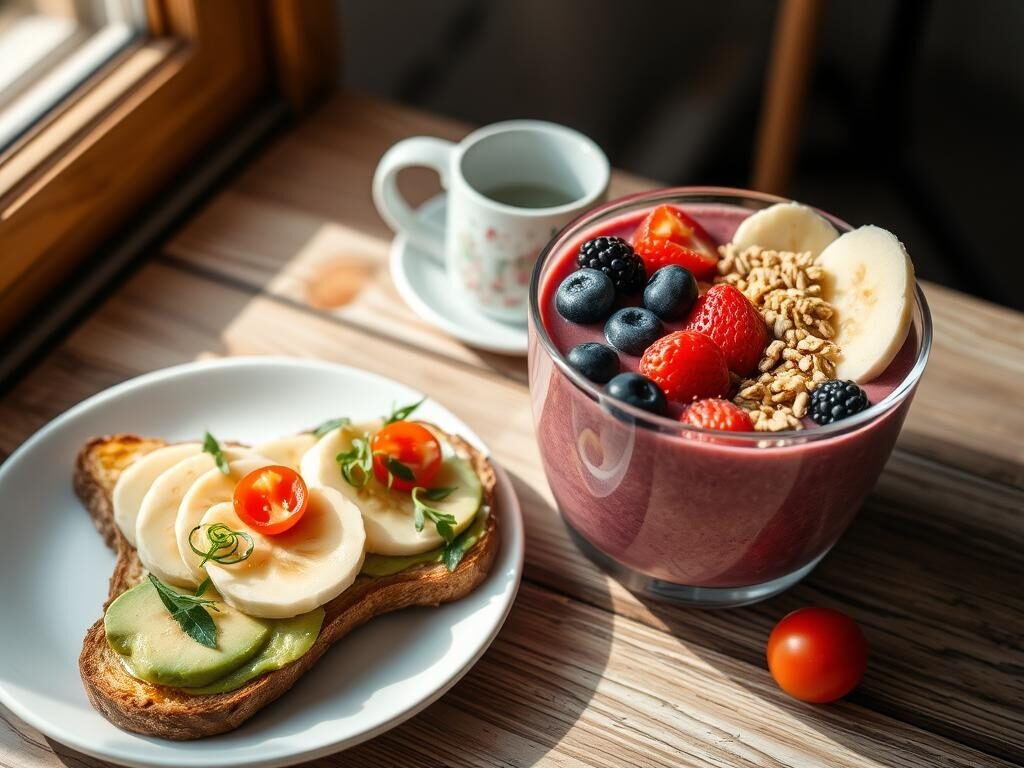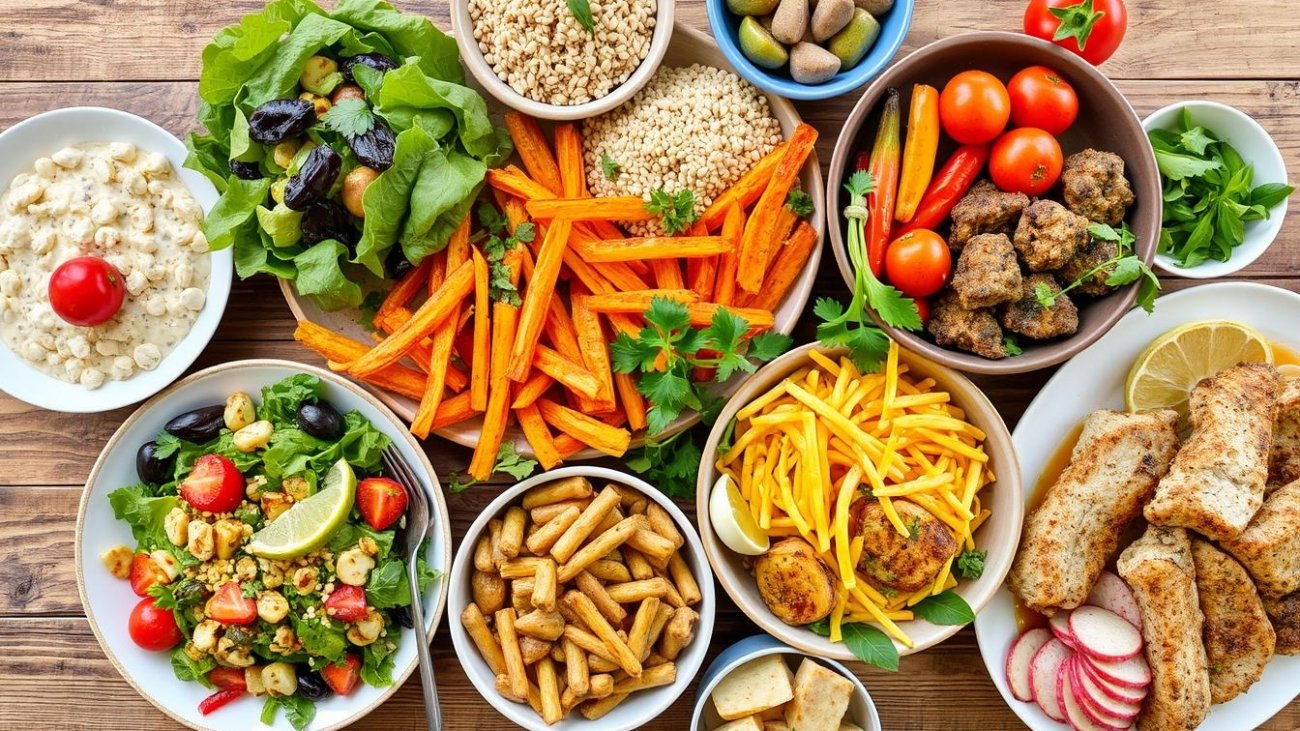Welcome to a world of tasty and healthy meals. This guide will show you easy recipes that are both delicious and nutritious. These dishes are perfect for anyone wanting to eat better, manage dietary needs, or just enjoy tasty, healthy food.
Starting a healthy eating journey is easy. With some knowledge and creativity, you can make your kitchen a place of healthy, tasty meals. This article will give you the tools and ideas to make healthy eating a part of your daily life.
Key Takeaways
- Discover the fundamentals of balanced nutrition and the importance of essential macronutrients and micronutrients.
- Learn how to stock your kitchen with the right tools and plan your meals for success.
- Explore a variety of easy, healthy recipes that cater to different dietary needs and preferences.
- Understand the benefits of incorporating superfoods into your daily menu for added nutritional punch.
- Develop strategies for meal prepping and smart snacking to maintain a healthy lifestyle.
Understanding the Fundamentals of Balanced Nutrition
Keeping a balanced diet is key for good health and happiness. At the core are macronutrients and micronutrients. Knowing how they work together helps you choose better for your health.
Essential Macronutrients for Optimal Health
Macronutrients are our main energy sources. They include carbs, proteins, and fats. Each one is crucial for our body’s functions and health.
- Carbohydrates fuel our cells and keep us going all day.
- Proteins build and fix our muscles, tissues, and organs.
- Fats help make hormones, absorb nutrients, and keep organs warm.
The Role of Micronutrients in Your Diet
While macronutrients give us most of our calories, micronutrients are just as vital. Vitamins and minerals support our immune system, bone health, and more.
| Micronutrient | Key Functions |
|---|---|
| Vitamin A | Supports eye health and immune function |
| Vitamin C | Promotes collagen production and antioxidant protection |
| Calcium | Maintains strong bones and teeth |
| Iron | Helps transport oxygen throughout the body |
Daily Nutritional Requirements
To keep a balanced diet and meet your nutritional needs, know the daily amounts of macronutrients and micronutrients. These needs change with age, gender, and activity level. Always talk to a healthcare expert or dietitian for advice tailored to you.
Getting Started: Kitchen Essentials and Meal Planning
Starting to cook healthy meals at home is easy with the right kitchen tools and a good meal planning plan. Whether you’re new to cooking or have been doing it for years, these basics are key to your healthy cooking journey.
Essential Kitchen Tools for Healthy Cooking
Having the right tools in your kitchen makes meal prep easier and helps you cook healthy, balanced meals. Here are some must-haves:
- High-quality chef’s knife for efficient and safe chopping
- Sturdy cutting board to prepare fresh produce and lean proteins
- Measuring cups and spoons for accurate ingredient portioning
- Blender or food processor for creating smoothies, dips, and sauces
- Baking sheets and roasting pans for oven-based meal prep
- Airtight storage containers to preserve freshness and reduce food waste
Effective Meal Planning Strategies
Meal planning helps you eat well and saves you from daily meal stress. Here are some tips to get you started:
- Create a weekly menu with a variety of healthy foods
- Make a detailed grocery list to avoid impulse buys and have all you need
- Prepare meal parts ahead, like chopping veggies or marinating proteins, to make cooking easier
- Try recipes that can be made ahead or frozen for quick, healthy meals
By getting the right kitchen tools and using smart meal planning strategies, you’ll enjoy cooking healthy meals at home. Make it a fun and nourishing part of your life.
| Kitchen Tool | Purpose |
|---|---|
| Chef’s Knife | Efficient and safe chopping of produce and proteins |
| Cutting Board | Prepare fresh ingredients without cross-contamination |
| Measuring Cups/Spoons | Ensure accurate portioning for balanced nutrition |
| Blender/Food Processor | Create healthy sauces, dips, and smoothies |
| Baking Sheets/Pans | Roast vegetables and bake healthier meals |
| Storage Containers | Preserve freshness and reduce food waste |
Smart Shopping: Selecting Fresh and Wholesome Ingredients
Going to the grocery store can feel overwhelming, especially when you want to eat healthy. But, with some knowledge, you can pick out fresh, nutritious foods. These foods will make your body happy and your taste buds dance. Let’s look at how to shop smart and add healthy foods to your meals.
Seasonal Produce Guide
Shopping for seasonal produce is a great way to get the best taste and nutrition. Produce in season is usually cheaper and packed with nutrients. Here’s a quick guide to some top seasonal picks:
- Spring: Asparagus, peas, strawberries, and spinach
- Summer: Tomatoes, zucchini, blueberries, and sweet corn
- Fall: Apples, pumpkin, Brussels sprouts, and kale
- Winter: Citrus fruits, broccoli, potatoes, and brussels sprouts
Reading Nutrition Labels
When buying organic foods and fresh produce, reading labels is key. Look for items with less sugar, salt, and bad fats. Choose ones with more vitamins, minerals, and fiber. Check serving sizes and daily values to get the most nutrition for your money.
Budget-Friendly Shopping Tips
Eating well doesn’t have to cost a lot. Here are some ways to shop smart and save money:
- Plan your meals and make a shopping list before you go.
- Buy produce in season to save money.
- Choose frozen or canned fruits and veggies for a good alternative.
- Go for generic or store-brand items when you can.
- Buy bulk on items you use a lot, like grains, nuts, and spices.
By using these tips, you can fill your kitchen with fresh, wholesome ingredients without spending too much. Making small changes in how you shop can greatly improve your health and happiness.
Quick and Easy Breakfast Ideas for Busy Mornings
Mornings can be chaotic, but you don’t have to skip breakfast. A healthy breakfast gives you the energy and nutrients you need. Here are some quick meals and morning nutrition ideas that are tasty and energy-boosting.
- Overnight oats: Prepare a batch of nutrient-dense overnight oats the night before. Top with fresh fruit, nuts, and honey for a quick breakfast.
- Avocado toast: Toast whole-grain bread, mash avocado, and add salt, pepper, and lemon juice. It’s creamy and packed with protein.
- Smoothie bowls: Blend fruits, greens, yogurt, and nut butter for a thick smoothie. Pour into a bowl, top with granola, bananas, and honey.
| Breakfast Idea | Preparation Time | Nutritional Benefits |
|---|---|---|
| Veggie Frittata Muffins | 30 minutes | High in protein, fiber, and essential vitamins and minerals |
| Greek Yogurt Parfait | 5 minutes | Rich in calcium, probiotics, and antioxidants |
| Chia Seed Pudding | 10 minutes (plus chilling time) | Packed with omega-3s, fiber, and protein |
Try these quick and easy breakfast ideas to start your day right. They’re balanced and healthy, giving you energy all morning.

“Breakfast is the most important meal of the day, so make it count with nutritious, energy-boosting foods.”
Healthy Food Recipe: Power-Packed Lunch Options
Starting your day with a nutritious lunch is key for energy and focus. Making lunches ahead of time can make meal planning easier. This way, you can enjoy healthy meals without daily stress. Let’s look at some tasty and healthy lunch ideas that will keep you going all day.
Make-Ahead Lunch Recipes
Meal prep is a big part of healthy lunches. Spend a bit of time on the weekend or a free evening to make several healthy lunches. These can be packed and enjoyed all week. Here are some great make-ahead lunch ideas:
- Quinoa and Roasted Vegetable Salad: Cook quinoa and mix it with roasted veggies, chickpeas, and a tasty dressing. It’s full of protein and fiber.
- Greek Yogurt and Fruit Parfaits: Layer Greek yogurt, fresh berries, and some granola or nuts. It’s a filling and balanced meal.
- Chicken and Brown Rice Burrito Bowls: Make tender chicken, brown rice, and your favorite toppings like avocado and salsa. It’s a portion-controlled and meal prep friendly choice.
Portion Control Guidelines
For healthy lunches, it’s important to control portions. This ensures a balanced diet. Here are some tips for portion sizes:
- Protein: Aim for 4-6 ounces of lean protein like grilled chicken or tofu.
- Carbohydrates: Choose whole grains, quinoa, or sweet potatoes over refined carbs.
- Vegetables: Fill half your plate with colorful, nutrient-rich veggies.
- Healthy Fats: Add a small amount of healthy fats like avocado or nuts.
- Hydration: Always drink water or herbal tea with your lunch.
By using these make-ahead lunch recipes and portion guidelines, you can enjoy healthy lunches all day. Focus on meal prep and balanced meals to make your routine easier and support your health.
Nutritious Dinner Solutions for the Whole Family
It can be tough to make healthy dinners for everyone. But, with some smart strategies and tasty recipes, you can make family meals that are kid-friendly and full of balanced nutrition.
To make healthy dinners that everyone likes, focus on dishes with lots of essential nutrients. Use lean proteins like grilled chicken or baked fish. Add complex carbs like whole grains or roasted veggies. Finish with a fresh salad or steamed side for a balanced meal.
For families with picky eaters, try a “build-your-own” dinner. This lets everyone pick what they like. For example, a taco bar with different proteins, veggies, and toppings is a hit. It lets everyone make a balanced nutrition plate that they enjoy.
| Healthy Dinner Ideas | Key Nutrients |
|---|---|
| Baked Salmon with Roasted Sweet Potatoes and Steamed Broccoli | Omega-3 fatty acids, vitamins A and C, fiber |
| Grilled Chicken Fajitas with Sautéed Peppers and Onions, Whole Wheat Tortillas | Lean protein, complex carbohydrates, vitamin C |
| Vegetable Stir-Fry with Brown Rice and Tofu | Plant-based protein, fiber, vitamins and minerals |
The secret to family meals that everyone loves is balanced nutrition. Mix in different flavors and textures. And let everyone add their own twist. With a bit of creativity and planning, you can make healthy dinners that are good for both body and soul.

Smart Snacking: Healthy Alternatives to Processed Foods
In today’s fast world, it’s easy to grab processed snacks. But, with some planning, you can enjoy healthy snacks that are tasty and full of energy. Let’s look at some yummy and natural food choices for mindful snacking.
Energy-Boosting Snack Ideas
When you’re hungry, having energy-boosting snacks is key. These snacks keep your energy up all day, avoiding the afternoon crash. Here are some great options:
- Fresh fruit and nut butter: A sliced apple or banana with nut butter is perfect.
- Yogurt and granola: Greek yogurt with wholesome granola is full of protein and carbs.
- Veggie sticks and hummus: Crunchy veggie sticks with hummus are nutritious and filling.
Portion-Controlled Treats
You don’t have to give up sweets to stay healthy. Choose portion-controlled treats for a mindful snack. Here are some ideas:
- Dark chocolate squares: A small piece of dark chocolate is sweet and has antioxidants.
- Frozen fruit pops: Blend fruits, pour into molds, and freeze for a sweet treat.
- Baked fruit crisps: Slice apples, pears, or peaches, add cinnamon, and bake until crispy.
Adding these healthy snack options to your diet can make you feel balanced and full of energy.
Meal Prep Strategies for Success
Meal preparation is a big help for a healthy diet. A little time upfront can make a big difference. Let’s look at some meal preparation tips that save time and help you eat healthy all week.
Batch Cooking for Convenience
Batch cooking is a great time-saving tip. Spend a few hours on the weekend cooking big batches of healthy meals. You can roast veggies, cook grains, or make a big pot of soup. This way, you can easily make balanced meals all week.
Proper Food Storage
Storing food right is key to keeping it fresh. Use airtight containers and label them. Store them in the fridge or freezer as needed. This keeps your batch-cooked food fresh longer and cuts down on waste.
Organize Your Meals
Planning meals for the week can change the game. Spend some time on the weekend planning your meals and making a grocery list. This helps you have the right ingredients and avoids unhealthy last-minute choices.
| Meal Prep Tip | Benefits |
|---|---|
| Batch Cooking | Saves time, ensures consistent healthy meals |
| Proper Food Storage | Maintains freshness, reduces food waste |
| Meal Planning | Ensures balanced meals, reduces last-minute decisions |
Adding these meal preparation tips to your routine can really help your healthy eating journey. A bit of effort upfront leads to nutritious meals all week.
Incorporating Superfoods into Your Daily Menu
Superfoods are packed with nutrients and offer many health benefits. They include berries rich in antioxidants and greens full of fiber. These foods are a great source of vitamins, minerals, and phytonutrients, helping you stay healthy.
Benefits of Common Superfoods
Kale, spinach, and other leafy greens are full of vitamins A, C, and K. They also have minerals like calcium and iron. Blueberries, acai, and goji berries are known for their antioxidants, protecting cells from damage.
Chia seeds and flaxseeds are rich in omega-3 fatty acids and fiber. They help keep your heart and digestive system healthy.
Creative Ways to Use Superfoods
Adding superfoods to your meals is simple. Begin with a smoothie made with spinach, blueberries, and chia seeds. Sprinkle chia or flaxseeds on your oatmeal or yogurt.
Add kale or arugula to your salads. For a healthy snack, try almonds or roasted edamame. There are many ways to make your meals more nutritious with superfoods.

Add a Comment